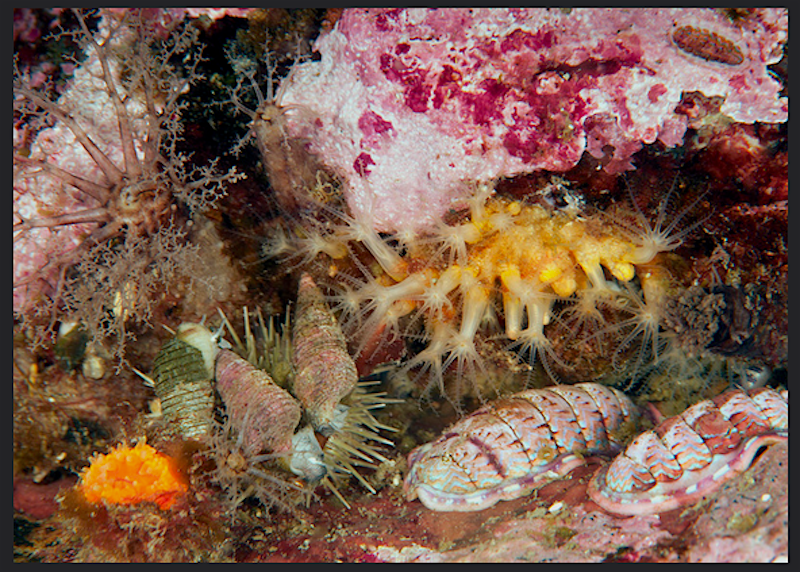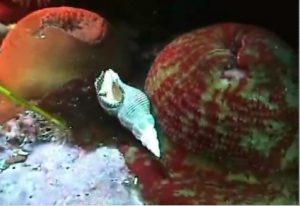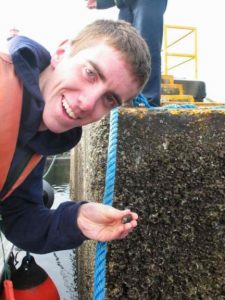Henry Steinberg, Julia Clarke and Laura Verhegge do their first tether dive with Chris off the shores of Race Rocks in Race Passage. The apparatus for the dive was constructed by Henry Steinberg, a Pearson College diver, as part of a project in his PADI Divemasters course. This type of diving is useful for research purposes when one wants to sample jellyfish, salps or other macro-planktonic life forms which may otherwise be damaged if collected in a towed plankton net. It is also necessary as a safety measure for drift diving when the bottom is beyond safety limits, and there are currents involved such as here in the Strait of Juan de Fuca.
Daily Archives: Sunday,May 15, 2005
Lirabuccinum dirum: Spindle whelk–The Race Rocks Taxonomy
Habitat: Middle intertidal zone on wave-washed, coralline-encrusted rocky shores. Can be found on protected outer coasts and quiet bays anywhere from Alaska, south to central California.
At Race Rocks, they occur frequently in the mid to low intertidal range. They have often shown up in intertidal transects.
Description: The Spindle Whelk has a thick, mainly grey shell with many spiral threads of varying sizes. The soft body of the animal is white. Shell is heavy; whorl sculptured with spiral grooves and 9 round, low axial swellings. The siphonal canal is short and coloured grey or brownish.
Additional Information: The spindle whelk is a scavenger that feeds mainly on injured animals. Prey can include littorines, snails, barnacles, worms and limpets. The Spindle Whelk’s proboscis can extend fully out of the shell which allows for gregarious feeding on large prey. Additionally, the proboscis permits the consumption of prey that are already being digested by the everted stomach of sea stars. Its main predator is the sea star. Spindle whelks are most active when submerged in calm water; otherwise it is a largely inactive animal. The longevity of the spindle whelk is unknown, however one which is 40 mm long could be 15 years or more in age.
Kingdom: Animalia
Phylum Mollusca
Class Gastropoda
Subclass Caenogastropoda
Superfamily Buccinoidea
Family) Buccinidae
Genus Lirabuccinum
Species: dirum
Formerly Searlesia dira
Common Name dire whelk or spindle whelk
Other Members of the Phylum Mollusca at Race Rocks.
| Return to the Race Rocks Taxonomy and Image File |
|
 The Race Rocks taxonomy is a collaborative venture originally started with the Biology and Environmental Systems students of Lester Pearson College UWC. It now also has contributions added by Faculty, Staff, Volunteers and Observers on the remote control webcams. The Race Rocks taxonomy is a collaborative venture originally started with the Biology and Environmental Systems students of Lester Pearson College UWC. It now also has contributions added by Faculty, Staff, Volunteers and Observers on the remote control webcams.
|
Elephant Seal Moulting
Race Rocks is at the northern limit of distribution of the Elephant Seal. They often number from 2 to 3 large males and 4 or 5 females. Arriving in January, they usually stay through the summer on the middle island and then leave for several months in the winter. Elephant seals often undergo a juvenile moult on the local beaches of Victoria when several years old. This individual may be at the end of such a moult as it still has a few sore spots on it’s coat. They end up on beaches where they wallow in the sand to keep the flies off. Members of the public often report them to the “authorities” as being diseased in appearance as their skin is blistered and raw. There has even been an example in the past few years in the local Victoria area when an animal in such condition was reported to the authorities as sick and due to ignorance, the animal was shot by an animal control officer. Of course this outraged some of some local residents who had been observing it for weeks as it was going through the moult, but the mistake had been made. So humans — leave well enough alone. Misguided intervention is not helpful for this rather rare pinniped
The video of this female elephant was videoed off the South side of Race Rocks. It was done in hi 8 – before we had SONY cameras that would record in Digital. One can see the patchy skin typical of the moulting stage just behind the head. This seal had probably already gone through the most serious part of the juvenile moult, which may have occurred on one of the sandy beaches over near Metchosin. The barking in the background is from California sealions.



